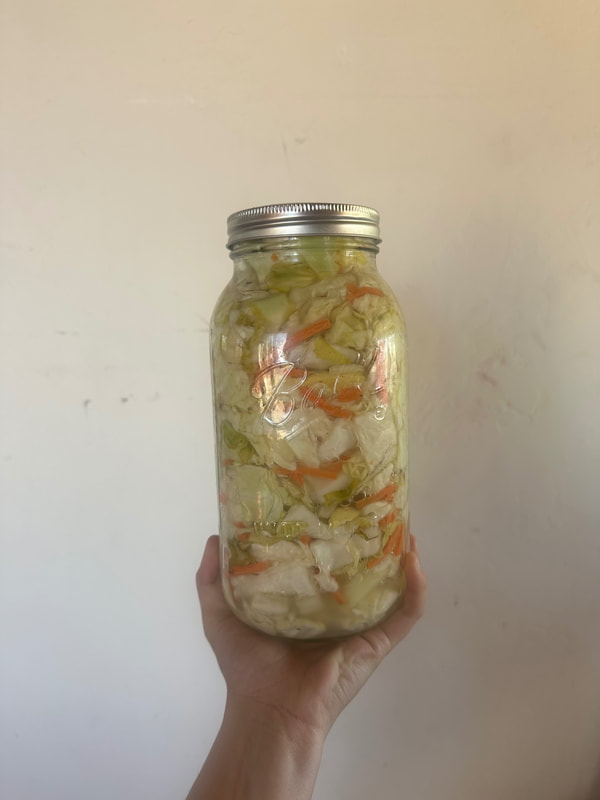|
This kimchi is an essentialist simplification of kimchi. Green cabbage is arguably available everywhere, and even organic cabbage is widely available. It also lasts a long time in the fridge or on the counter.
This recipe can even be reduced further so that the result is sauerkraut. Note on salt: use plain table salt or pickling salt. Do not use mineralized salt. 1 whole green cabbage (can usually fit into a half gallon mason jar, if you really stuff it!) Jar(s) Salt 1 tbs Korean chili flakes or gojuchang paste (use less if you’re unsure about spicy level. Use more more for more spicy.) (Optional) Gloves, to keep chili off of your hands Optional: Flavorings 1 teaspoon grated ginger Fish sauce Soy sauce 1-3 teaspoons of sugar (brown sugar is good too) Garlic - you can go crazy here, they can go in whole or you can mince them, or do whatever. All good. Bonus veggies: Radish, sliced into matchsticks or quarter moons Dandelion greens- just rip them up and put them in Onion - any kind, slice them up or keep them chunky Apple or pear, sliced Carrot Kale Raw oysters (I know, crazy) Anything that is about to go bad, that is fibrous. No spinach. Directions Reserve several large cabbage leaves. Cut cabbage into quarters, top to bottom. This makes the cabbage workable. Decide what shape you want the cabbage in, do you want think shreds or quarts or rectangles? Shreds will ferment quicker because of the larger surface area. Discard the tough stem - or be adventurous and consciously add it to your ferment. Put the chopped cabbage in a large bowl. Sprinkle with salt, like you’re seasoning a salad. You don’t want it too salty or too bland. Rough up the salted cabbage with your hands, squishing and crunching it. You’re breaking down the cell walls so it’s easier for fermentation to start. (Add bonus veggies here) Let sit, so water starts to sweat out of the cabbage. Add chili flakes or gojuchang paste and incorporate. Optional: more flavorings. If you’re wanting to add soy sauce or fish sauce, rinse off some of the salt from the cabbage. Taste the cabbage before you put it in the jar. You still want it seasoned with an appropriate amount of salt. Now stuff - really stuff- your glass jar. If I’m using a jar with a big enough mouth, I use my hand to press the cabbage down as much as possible, so there are no gaps in the cabbage. Fill it very close to the top, and pour any liquid from the bowl into the jar. Take the reserved cabbage leaf and cover the kimchi, tucking it in around the edge of the jar. The goal here is to create a water lock, where air does not touch the kimchi. If there is enough liquid from the bowl to cover the cabbage, perfect, if not, top up the jar with some purified water. Cover the jar with a cheese cloth or parchment paper, secured with a rubber band or the jar ring. The fermentation will rust a lid, so you need to have something else in place. You just want something in between the contents of the jar and the lid. Do not fully close a lid, since there will be gas forming in the jar. You do NOT want exploding kimchi. I’m speaking from experience. Nothing like a 6 foot geyser of kimchi juice. Just saying. Fermentation time! Let it sit on the counter for a few days. You’ll start to see bubbles form in the jar after a few hours, depending on how warm it is. Start tasting it after a day, so you can start to understand the process and the funkiness of it. After tasing, make sure all the cabbage is still submerged. When it starts to taste like you like it, move it in the fridge to slow the fermentation process, or just start eating it with every meal because it’s so good and you’re going to eat the whole giant jar in a few days anyway, lol. (Kimchi lasts a good three weeks on the counter with no refrigeration. If you start to see any mold, scoop it out) If the kimchi starts to get soft, and it’s not as pleasant to eat on it’s own, make kimchi pancakes/latkes. They’re sooo good, even served with applesauce and or sour cream. Enjoy! |
ArchivesCategories |




 RSS Feed
RSS Feed